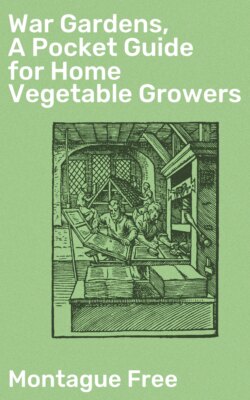Читать книгу War Gardens, A Pocket Guide for Home Vegetable Growers - Montague Free - Страница 4
ОглавлениеWAR GARDENS
I
THE VALUE OF BACK-YARD AND VACANT-LOT GARDENING
The National War Garden Commission has estimated that “the people of this country in 1917 produced a crop valued at three hundred and fifty million dollars in gardens cultivated in back yards, on vacant lots, and on other land previously untilled.” This may seem a small amount when compared with the value of the crops raised by the farmers and market gardeners, but it is not to be despised, and it shows that something can be done to increase the food supply by home gardening.
The raising of vegetables at home not only increases food production, but also stimulates the consumption of vegetables, thus releasing staples, such as wheat and meat, for the use of our soldiers and the Allies. This result is attained partly because fresh vegetables are more appetizing than shop-worn products and partly because of the attitude of the raiser, who says, “We have the stuff and may as well eat it.”
The reduction in the cost of living is also a factor that must be considered. When vegetables are bought their purchase price is quite a considerable item in the household budget. Of course if labor is figured in the cost of raising vegetables at home the financial returns are not likely to be large unless you take into consideration the fact that the necessity of paying dues for gymnasium, tennis, or golf is entirely eliminated. Plenty of fresh air and exercise can be obtained in gardening.
Home gardening, too, should help the transportation problem to a certain extent. Most of the vegetables consumed in the large cities are transported a considerable distance, and if those people who eat these much-traveled vegetables raise their own, the transportation system will be relieved to that amount.
The raising and caring for plants is certain to broaden one’s interest. Very few people who cultivate a vegetable-garden, or any other kind of garden, for that matter, are likely to be satisfied until they know something of the physiology of plants, how and why they grow, and the principles underlying successful plant culture. The insects, both beneficial and otherwise, that one becomes acquainted with in the garden also add their quota of interest. The life histories of many of them are strange and marvelous, and it is worth while, both from the point of view of the welfare of the crops and from the educational standpoint, to learn something of their habits.
But it is probably in the larger aspects of the situation that the home-garden movement will ultimately be of greatest value to the nation. America is not a gardening nation judged from European standards, but this agitation for the production of food by every one who has, or can obtain, a plot of ground is going to make us one. Those people who have once cultivated the ground and raised plants will have had their interest stimulated, and when the food shortage is over their activities will find an outlet in the production of flowers, which cannot but result in more beautiful cities and happier citizens.
A healthier population will result from the exercise in the open air and we shall become a less nervous and restless people through our association with the vital soil and living, growing plants.
